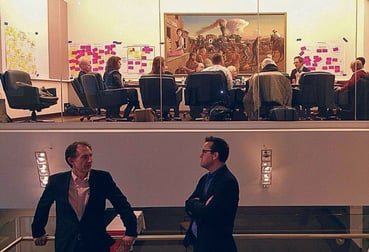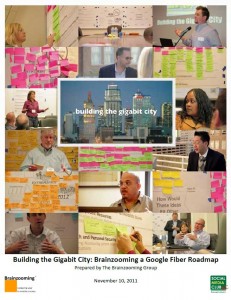 The Building the Gigabit City 2.0 event on February 13 in Kansas City was an incredible day in so many respects.
The Building the Gigabit City 2.0 event on February 13 in Kansas City was an incredible day in so many respects.
The Mozilla Foundation launched the event to stimulate proposal submissions for its $150,000 Mozilla Gigabit Community Fund in Kansas City.
The Brainzooming Group designed the afternoon interactive session for the day-long event. Throughout the afternoon, well over 100 participants imagined and described app and technology concepts to improve education, workforce development, digital access, and other areas within the Kansas City community and beyond.
Building the Gigabit City 2.0
With the number and range of participants at the majestic Kansas City Public Library, we recruited an extended team to facilitate six community-oriented tracks.
Our team included a mix of people - some we've known for a few months to others we’ve known for decades. All had facilitated, participated in, or tracked the Brainzooming strategic thinking methodology.
The fantastic strategic thinking session facilitation team included:
- Rick Binkley
- Jason Cupp
- Bob Fine
- Michael Irvin
- Bob King
- Andrew McHugh
- Matthew Murrie
- Eileen O'Hara
- Keith Prather
- Lisa Qualls
- Julie Robinson
- Mike Sherry
- Lyne Tumlinson
- Shari Wilson
To ensure the facilitation team was ready to help participants work on new app concepts, we prepared a more than 30-page facilitator's guide. The guide provided overviews on Mozilla objectives, background on each community group, and step-by-step overviews for using the Brainzooming exercises we designed.
Each facilitator brought their own expertise and experience to what we designed to bring it to life. We are so appreciative of everyone volunteering their time to make the event a success!
Strategic Thinking Learnings about the Brainzooming Methodology
Every time other people facilitate a Brainzooming strategic thinking session, it’s a fantastic learning opportunity both through facilitator comments and observing the groups. Among the strategic thinking learnings coming out of the Mozilla Gigabit Community Fund session we designed:
- The session emphasized how outcomes-based the Brainzooming methodology is. We start with what needs to come from a strategy session and design backwards, which creates a strong emphasis on production.
- The Brainzooming methodology gains speed (the “zooming” experience) by eliminating elements that don’t add to the final output’s quality. That sometimes means participants (and facilitators) don’t get the context they’d like (even though the results suggest they don’t need it).
- When you are monitoring group process but not facilitating, you rely on different cues. Rather than the content of the ideas, you depend on volume (of talking and of ideas), participant physical activity, posture, and eye contact as the primary signals for intra-session success.
Kudos to Kari Keefe of Mozilla and Aaron Deacon of KC Digital Drive who were the primary contacts Barrett Sydnor and I worked with leading up to the event.
Thanks also go to Alex Greenwood and the team at Alex G Public Relations for their work on, among other things, identifying the ideal spot above to do a video interview showcasing the visual impact of a Brainzooming session.
Building the Gigabit City 2.0 from LINC on Vimeo.
Now, we’re looking forward to seeing the variety of proposals coming forward to compete for funding! – Mike Brown
If you enjoyed this article, subscribe to the free Brainzooming email updates.
The Brainzooming Group helps make smart organizations more successful by rapidly expanding their strategic options and creating innovative plans they can efficiently implement. Email us at info@brainzooming.com or call us at 816-509-5320 to learn how we can help you enhance your strategy and implementation efforts.




